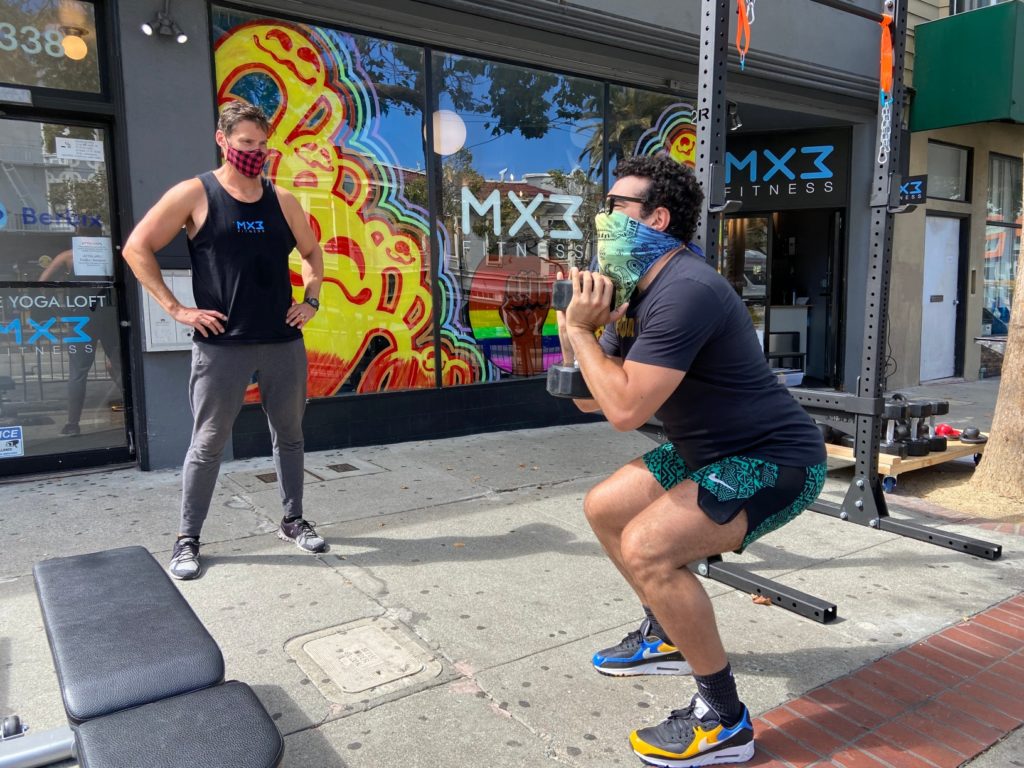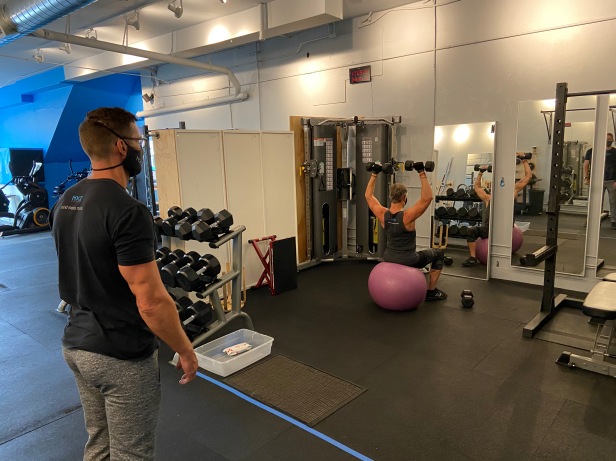Imagine going to a business conference, and then finding out that 13 out of the 20 people attending that conference had gotten COVID-19.
That’s exactly what happened to Dave Karraker, co-owner of MX3 Fitness, a personal training business in San Francisco, in March 2020. Testing was hard to come by then, but his doctor told him that he probably had it. He and his life and business partner, Glenn Shope, fellow co-owner, would both need to quarantine.
The very next day, the mayor of San Francisco announced the shelter-in-place order. Not only were both Dave and Glenn stuck in quarantine, but they had to shut down their business overnight—leading to a mad scramble to keep the business afloat amidst the pandemic.
Adapting to Changing Customer Needs
Prior to COVID-19, MX3 Fitness had been a healthy, thriving business. Founded in 2016, the company had grown to employ 14 employees in two locations in the Lower Haight and Castro districts of San Francisco in 2020. While many gyms simply rented out space to personal trainers, MX3 Fitness hired its own trainers to give clients highly personalized training tailored to each client’s unique needs.
As Dave notes, “Owning a small business is always about tenacity and resilience. Businesses constantly have to pivot based on customer needs. But COVID was the big test. You start a business because you have a passion for it, but you have to build it around what the consumer wants and where they are going.”
When the pandemic struck, MX3 Fitness customers were going home. The company had been charging clients in a pay-as-you-go model instead of through monthly memberships, and it lost 80% of its revenues overnight when it had to shut down.
With few options in sight, Dave and Glenn took immediate steps to take their business online. Glenn (luckily a former computer programmer) re-wrote the code for the website to allow for virtual training. He put all classes on Zoom and set up a Zoom scheduling client. They also had to equip trainers to teach online, using chairs, milk jugs, and other household items until they—and MX3 Fitness customers—could buy suddenly scarce home-gym equipment online.
Then in June, San Francisco announced the Shared Spaces program, allowing businesses to serve their customers on the sidewalk. Though Shared Spaces was designed with restaurants in mind, Dave and Glenn thought it would also work for their gym. So, with the aid of fit trainers and portable weight movers they built themselves, they pivoted again, moving all 6,000 pounds of equipment onto the sidewalk to accommodate outdoor workouts at four separate COVID-safe stations.
This initiative helped MX3 Fitness build goodwill and inspiration not just among their customers, but also within the community. “Our trainers provided not only training, but also emotional support, making everyone feel healthier and more hopeful that we would get through this,” says Glenn.
Securing Capital to Build for the Future
However, it was clear that creativity alone would not be enough to get the business out of the red. Dave and Glenn relied on Xero’s cloud accounting system to help them scrutinize all their expenses. Armed with this information, they determined where they could cut costs to help bring the business back to profitability. They laid off some employees and eliminated some unnecessary subscription services to help close the gap. Dave and Glenn also shared their books with their landlords, helping them to understand the situation and subsequently renegotiating their leases.
Based on their data in Xero, they also did some business modeling to determine what they would need to do to build back clientele and training staff as the pandemic eased. “Being able to very clearly see what we were spending on and cut out things we didn’t need in this new normal was critical,” according to Dave. “For instance, we eliminated the towel service, and I started doing the laundry.”
MX3 Fitness also needed to bring money into the business. In April 2020, Dave and Glenn applied for their first-round Paycheck Protection Program (PPP) loan. MX3 Fitness’s accounting partner, Dawn Hatch, Founding Partner at MATAX, had set up their Xero system to automate as much as possible, and continued to provide monthly services to fine tune it. As a result, MX3 Fitness’s books were in order and ready to produce the information and reports required to qualify for the loan within a day.
MX3 Fitness had to wait awhile for its bank to set up processing for PPP loans, but once it did, MX3’s information went into the system. In June, MX3 Fitness’s PPP loan was approved for loan forgiveness, and it used the proceeds to pay employees’ back wages.
MX3 Fitness received its second round of PPP financing in August 2020. Glenn and Dave used this loan to pay back rent owed to their landlords, and pay for what they had bought to create the outdoor workout space.
They used the rest of the money to buy new equipment to reconfigure their indoor workout areas. Dave and Glenn knew people would want to come back to the indoor workout space as the virus subsided, but they also believed that clients would be very concerned about social distancing and cleanliness. MX3 Fitness reconfigured their gyms, going from having all equipment in a common, shared space to creating personalized fitness zones, furnishing each with all the equipment needed for a workout. The company also made improvements to the ventilation and air-conditioning systems, and it hired two laid-off bartenders as gym assistants to clean and move equipment as required.
Back in the Black
Today, MX3 Fitness is back to its pre–COVID-19 trajectory—and back in the black. Dave and Glenn continue to tweak the business model. They’ve added a new option for clients to buy credits and work out on their own, instead of with a trainer. In May, MX3 also began offering a monthly membership—signing up 15 members in the first month. The gyms are also signing up five to seven new clients a week for pay-as-you-go services, which most clients use three times a week.
Glenn and Dave have hired two new personal trainers, for a current staff of eight, and are considering opening a third gym as more people get back to pursuing their fitness goals.
They also had MATAX add new tracking capabilities in Xero to delineate revenue streams among different locations and services. This information will provide more insight into the business to help them guide the business forward.
According to Dave, “PPP loans saved the day for us. We probably would have had to close or dig into our retirement money if we didn’t have them. But having our ducks in a row was really important too. Using Xero for accounting helped us be ready to go, so we could act quickly and qualify for and get our loans.”
Perspective
The MX3 Fitness story underscores three key takeaways from the pandemic.
First, it may be a cliché, but it’s true that change is the only constant—and you need to be ready for it. When the pandemic struck, MX3 Fitness and millions of other businesses suddenly had to adjust their business models, work environments, and offerings. As the virus recedes, businesses must continue to evolve to meet a new crop of opportunities and challenges.
Next, cash is king. Cash flow is key to surviving a crisis, and for getting back on a growth path as a crisis subsides. Building up cash reserves to see the business through typical gaps in income and expenses is critical, of course. When bigger challenges arise, businesses may also need to take advantage of favorable financing and loan programs, such as MX3 Fitness did, to weather the storm and rebound once the skies clear.
In fact, SMB Group’s 2021 SMB Technology Directions for a Changing World study indicates that small businesses that received a PPP loan were more than twice as likely to have increased revenues in 2020 compared to 2019, and are also much more likely to expect 2021 revenues to surpass those in 2020.
Finally, accurate, up-to-date financial information—or as Dave would say, “having your ducks in a row”—is essential to execute successfully in the two areas discussed above. According to SMB Group’s 2021 SMB Technology Directions for a Changing World, small businesses using an accounting solution were much more likely to grow or hold revenues steady than those that didn’t use any accounting software through the pandemic.
Furthermore, those using cloud accounting solutions, such as Xero, fared even better than those using on-premises (desktop or client-server) solutions, or a combination of cloud and on-premises solutions.
This isn’t surprising, as cloud accounting solutions put real-time information and reporting at your fingertips—helping you to identify, interpret, and execute in response to new opportunities and trends, and more accurately inform your business strategy.
Predicting the future is hard. However, having the data and insights you need can help you navigate through change much more successfully. Cloud accounting solutions provide you with the information you need, when you need it, to be better prepared for the next challenge or opportunity your business faces.
© SMB Group, 2021
Source: Laurie McCabe’s Blog








